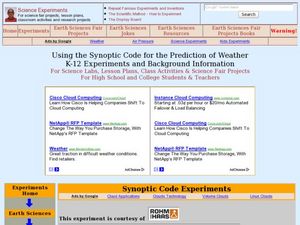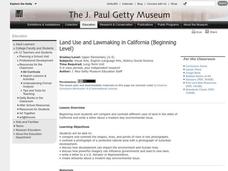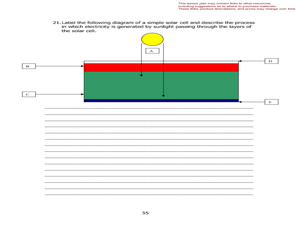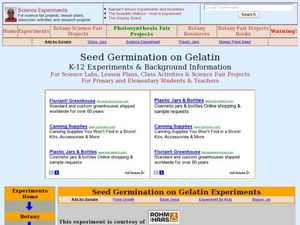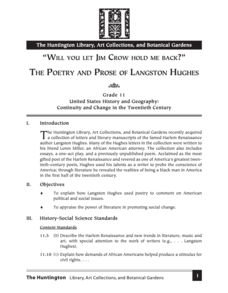Curated OER
Properties of Minerals
Young scholars research properties of minerals. In this science lesson, students search the web, create a folder, and store information on properties of minerals. There are many excellent worksheets and study guides embedded in this...
Curated OER
Worms: Nature's Recyclers
Students explore vermi-composting. In this vermi-composting lesson, students listen to the story Diary of a Worm and discuss the parts of a worm. They create worm bins and add organic food for the worms to recycle.
Curated OER
A Day Without Agriculture
Second graders define and create a list of agricultural products. In this producers and consumers lesson plan, 2nd graders participate in a contest to find as many types of agriculture as they can. The student who comes up...
Curated OER
Sunlight and Warm Air
Young scholars examine the different ways heat can be felt. In this radiation and conduction instructional activity, students recognize that the sun radiates heat. Young scholars conduct three experiments to find how the sun warms...
Curated OER
King Cotton
Fifth graders explore the cotton plant. In this cotton lesson, 5th graders research the process of growing cotton. Students explore the economic and cultural differences in the states that grew cotton for trade and industry.
Curated OER
Using the Synoptic Code for the Prediction of Water
Students construct a thermoscreen for the experiment. For this earth science lesson, students make observations and interpret them using synoptic codes. They predict the weather based on gathered information.
Curated OER
Seeds of Wetland Life
Students participate in several activities on seed exploration. In this biology lesson, students classify seeds according to their dispersal method. They explain the different adaptations plant have to disperse their seeds.
Curated OER
Where are all the Animals?
Students view animals that camouflage at the Shedd aquarium website. In this camouflage lesson, students recognize that there are different types of camouflage, cryptic coloring, counter-shading, warning coloration and mimicry. Students...
Curated OER
The Periodic Table of the Elements
Students research the elements used to create fireworks. In this periodic table activity, students discuss common metals, their characteristics, and their places on the periodic table. They work in small groups to research the elements...
Curated OER
Land Use and Lawmaking in California
Students investigate the laws of using land. In this California Government lesson, students examine the many uses of land in California and find an environmental issue they care about. Students write a letter to a politician...
Curated OER
Photovoltaics and Solar Energy
Students experiment with photovoltaic cells and determine the energy use of their appliances. In this renewable energy lesson, students calculate the energy emitted by a photovoltaic cell through an inquiry-based lab. They keep track of...
Curated OER
Heat Conductors
Students explore heat conductors. In this lesson on heat, students examine how heat passes through different conductors and how different materials contain heat.
Curated OER
Bison on the Plains
Fifth graders explore U.S. geography by reading assigned text about American Indians. In this migration lesson, 5th graders identify the differences between Native Americans and European settlers who traveled through middle America in...
Curated OER
Seed Germination on Gelatin
Young scholars examine how seeds germinate in a culture. In this germination lesson plan students germinate seeds in gelatin and observe the growth of the plant.
Huntington Library
The Poetry and Prose of Langston Hughes
Eleventh graders discover the poetry of Langston Hughes. In this social issues lesson plan, 11th graders experience the views of Langston Hughes. Students read Hughes' poetry and discuss the basic theme. Students evaluate the political,...
Curated OER
Finding Your Way On the Farm
Third graders explore the food industry by viewing a presentation about farming. In this farming geography lesson, 3rd graders view globes and maps while identifying the prime geographical locations for fertile land. Students view a...
Curated OER
Cows, Worms and Compost
Third graders explore agriculture by viewing a PowerPoint presentation in class. In this animal relationship instructional activity, 3rd graders identify the types of farm animals humans feed on and their dependency on such small insects...
Curated OER
Corn: An A--Maizing Plant
Third graders examine the history of corn. In this agriculture lesson plan, 3rd graders discuss the history of corn and identify the corn belt on a map. Students dissect kernels of corn and discuss their observations.
Curated OER
Loco for Cocoa
Third graders research the history of cocoa. In this cocoa lesson plan, 3rd graders investigate how the cocoa bean has been traded from one country to another. Students create a timeline and map to track the history of the cocoa bean.
Curated OER
Rain On
Fourth graders explore evaporation and condensation. In this water cycle lesson, 4th graders investigate their surroundings for real-life examples of evaporation and condensation. Students conduct various experiments.
Curated OER
Soil in My Food Web
Fourth graders understand the importance of soil to the food web. In this food web lesson, 4th graders create various food webs beginning with soil using yarn and name cards. Students write about the importance of soil to one...
Curated OER
What's in the Soil?
Fourth graders examine soil to find its contents, and how much water and air they can measure. In this soil composition lesson, 4th graders perform three experiments and record their results. In one experiment they examine...
Curated OER
Cacao Tree Geography
Students use a map to learn about where chocolate comes from. In this lesson on the cacao tree, students locate various regions where the cacao tree grows. They will discuss why the cacao tree grows more favorably in particular climates...
Curated OER
A Map Mystery
Second graders solve a map mystery. In this technology lesson plan, 2nd graders develop an awareness of maps and the symbols associated with maps as they the "Neighborhood Map Machine."





